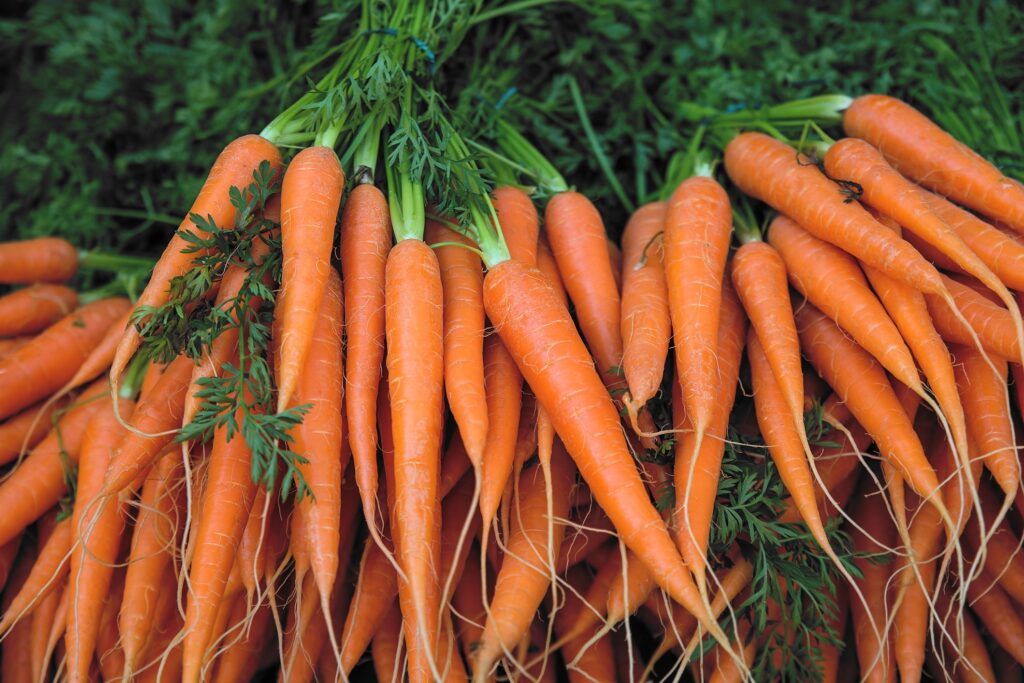HOLISTICALLY YOURS·THURSDAY, 16 MAY 2019
This week, the Letter C – there are so many amazing Fruit and Vegetables to eat and of course listing them all would take for ever and a day! SO, I have tried to pick those that are probably the most popular. We are lucky as fruit and veg is still quite seasonal here, and eating them in season is when you will gain the most benefits. So if you see something you have been waiting for – go for it, enjoy it!
Carrots

Health benefits:
Crunchy, tasty, and highly nutritious.
Carrots are a particularly good source of beta carotene, fibre, vitamin K1, potassium, and antioxidants.
They also have a number of health benefits.
They’re a weight-loss-friendly food and have been linked to lower cholesterol levels and improved eye health.
What’s more, their carotene antioxidants have been linked to a reduced risk of cancer.
Carrots are found in many colours, including yellow, white, orange, red, and purple.Orange carrots get their bright colour from beta carotene, an antioxidant that your body converts into vitamin A.
Nutrition facts
Carrots’ water content ranges from 86–95%, and the edible portion consists of around 10% Carrots contain very little fat and protein.
The nutrition facts for two small-to-medium raw carrots (100 grams) are:
Calories: 41
Water: 88%
Protein: 0.9 grams
Carbs: 9.6 grams
Sugar: 4.7 grams
Fibre: 2.8 grams
Fat: 0.2 grams
Carrots are mainly composed of water and carbs.
The carbs consist of starch and sugars, such as sucrose and glucose.
They are also a relatively good source of fibre, with one medium-sized carrot (61 grams) providing 2 grams.
Carrots often rank low on the glycemic index (GI), which is a measure of how quickly foods raise blood sugar after a meal.
Their GI ranges from 16–60 — lowest for raw carrots, a little higher for cooked ones, and highest for puréed.
Eating low-glycemic foods is linked to numerous health benefits and considered particularly beneficial for people with diabetes.
Fibre
Pectin is the main form of soluble fibre in carrotsSoluble fibres can lower blood sugar levels by slowing down your digestion of sugar and starch.
They can also feed the friendly bacteria in your gut, which may lead to improved health and decreased risk of disease.
What’s more, certain soluble fibres can impair the absorption of cholesterol from your digestive tract, lowering blood cholesterol.
The main insoluble fibres in carrots are cellulose, hemicellulose, and lignin. Insoluble fibres may reduce your risk of constipation and promote regular bowel movements.
Carrots are about 10% carbs, consisting of starch, fibre, and simple sugars.
They are extremely low in fat and protein.
Vitamins and minerals
Carrots are a good source of several vitamins and minerals, especially biotin, potassium, and vitamins A (from beta carotene), K1 (phylloquinone), and B6.
Vitamin A: Carrots are rich in beta carotene, which your body converts into vitamin A. This nutrient promotes good vision and is important for growth, development, and immune function.
Biotin: A B vitamin formerly known as vitamin H, biotin plays an important role in fat and protein metabolism.
Vitamin K1: Also known as phylloquinone, vitamin K1 is important for blood coagulation and can promote bone health
.Potassium: An essential mineral, potassium is important for blood pressure control.
Vitamin B6: A group of related vitamins, B6 is involved in the conversion of food into energy.Carrots are the perfect snack — crunchy, full of nutrients, low in calories, and sweet.
They’re associated with heart and eye health, improved digestion, and even weight loss.
This root vegetable comes in several colours, sizes, and shapes, all of which are great additions to a healthy diet.
CHERRIES

Cherries are one of the top antioxidant-rich foods (with capacity to hold nearly 5,000 in a one cup serving) and have been linked to reducing pain and inflammation associated with inflammatory arthritis and gout. They are one of the few natural sources for melatonin, which can help regulate sleep cycles.
The deep red color of dark-sweet cherries means the fruit contains anthocyanins (a type of antioxidant) that plays a role in improving cognitive function and protects the heart and its surrounding tissues.
They can also aid in workout recovery!
This super summer fruit scores a low 22 on the glycemic index, making cherries great for maintaining blood sugar levels, especially for those with diabetes.
Cherries contain boron to maintain calcium balance, promote bone health, and prevent osteoporosis.
They have potassium to help muscle, heart, kidney, and nerve cells function.
What Nutritional Value Do Cherries Have?
Cherries are loaded with antioxidants and polyphenols that help fight disease.
Calories, Carbohydrates and Sugars
One portion of cherries contains 97 calories, 25 grams of carbohydrates and 20 grams of sugar.
A drawback of this fruit is that a large percentage of its calories come from sugar.
87 Calories in a one cup serving of sweet cherries
16% Vitamin C Daily Value
10% Dietary Fibre Daily Value0 Grams of fat, sodium, and cholesterol
260 Milligrams of potassium(a helpful electrolyte)
Fibre
One of the benefits of cherries is their fibre content. With 3 grams of fibre, cherries provide 13 percent of the recommended daily amount. Fibre promotes digestion, prevents constipation and aids in weight loss.
Vitamins
Cherries contain 10.8 milligrams of Vitamin C. This vitamin is necessary for the collagen formation of bones, blood, muscle and blood vessels and helps the body absorb iron.
The fruit also contains beta carotene and provides low amounts of vitamin K, vitamin B-6 and vitamin A.
Minerals
The potassium level of cherries is 342 milligrams, or 10 percent of the daily recommended intake. Potassium helps the heart and kidneys function properly, and supports the body’s digestive and muscular systems. Cherries also contain some copper, manganese, magnesium, iron, calcium, phosphorus and zinc.
Sterols
Cherries are high in phytosterols. These plant sterols are used to lower “bad” cholesterol levels and reduce the risk of heart disease. Research at the Linus Pauling Institute at Oregon State University also suggests that phytosterols could help lower the risk of cancer and improve urinary tract symptoms. Cherries contain a carbohydrate that’s difficult to digest and may cause you to feel gassy and bloated. While there’s no way to get rid of the discomfort you feel after you eat the cherries, you may be able to take steps before you eat them to help reduce the bloating.
FODMAPs in Cherries
Cherries are considered a high-FODMAP, or fermentable oligo-di-monosaccharides and polyols, food. FODMAPs are a type of carbohydrate found in a variety of foods, including a number of healthy fruits and vegetables that are hard to digest. When these carbohydrates enter the colon, the bacteria ferment them, creating the gas and bloating. Some people also experience abdominal pain and diarrhea when they eat high-FODMAP foods like cherries.
Tips to Reduce Cherry Bloat
Eating small amounts and chewing your cherries well before swallowing may help reduce some of the discomfort. You may find that you tolerate canned cherries better than fresh, according to Monash University, as long as you don’t drink the liquid. Pickled cherries are also better tolerated.
Fruits contain the sugar fructose, which can cause issues for IBS sufferers. Fructose is particularly high in apples and pears, and somewhat high in watermelon, concentrated fruit, dried fruit and fruit juice. Fruits with lower levels of fructose include bananas, citrus, grapes and berries.
What to eat instead:
Eat fruits that are lower in fructose, such as banana, blueberry, boysenberry, cantaloupe, cranberry, grape, orange, lemon, lime, kiwi and strawberry.
Certain vegetables cause gas and abnormal bowel habits. Avoid cruciferous vegetables such as broccoli, cauliflower, cabbage, coleslaw and sauerkraut. Also, limit artichoke, brussel sprouts, onions, shallots, leeks, and asparagus.
What to eat instead: Vegetables that are good to eat include eggplant, green beans, celery, carrots, spinach, sweet potato, yam, zucchini, and squash. For more good options, see this chart. You can enhance flavours of these veggies with herbs. On the safe list, you’ll find: basil, chilli, coriander, ginger, lemongrass, marjoram, mint, oregano, parsley, rosemary and thyme.

A rainbow of colours on your plate will ensure you are getting the right nutrients in your diet, if you can’t eat something due to health issues, there are always alternatives, and whether you feel you can’t eat it because it’s not a nice taste, or you have visions of it slopped up on your plate at school meals, then choose other ways of cooking or serving!



